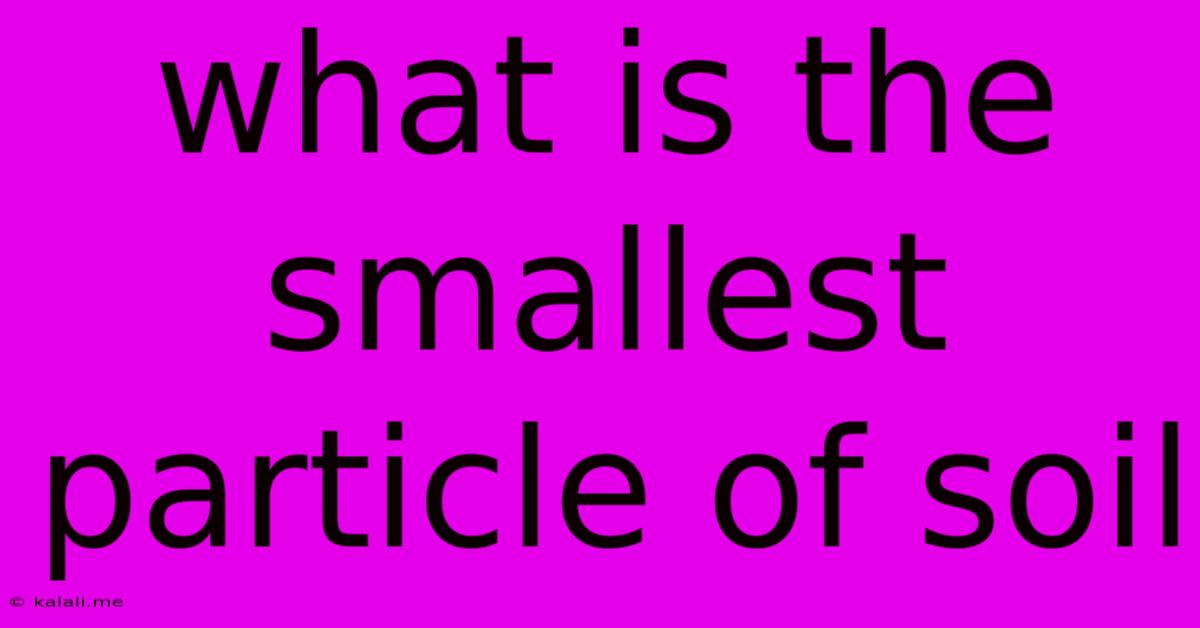What Is The Smallest Particle Of Soil
Kalali
Jun 13, 2025 · 3 min read

Table of Contents
What is the Smallest Particle of Soil? Delving into the Microscopic World of Soil Composition
Soil, the foundation of terrestrial life, is far more complex than it initially appears. Understanding its composition is crucial for agriculture, environmental science, and numerous other fields. This article delves into the question: what is the smallest particle of soil? The answer isn't as straightforward as you might think. It involves a journey from macroscopic components to the microscopic building blocks that define soil texture and properties.
While we often visualize soil as a homogenous mass, it's a heterogeneous mixture of various components. These components interact in complex ways, shaping the soil's physical and chemical characteristics. Let's break it down:
From Sand to Clay: The Primary Soil Particles
The most commonly discussed soil particles are sand, silt, and clay. These are not the smallest particles, but rather aggregates of smaller minerals and organic matter. Their size dictates soil texture:
- Sand: These particles are the largest, ranging from 0.05mm to 2mm in diameter. They feel gritty and are relatively easy to see with the naked eye. Sand particles are primarily composed of quartz.
- Silt: Silt particles are intermediate in size, ranging from 0.002mm to 0.05mm. They feel smooth and floury. Silt particles are composed of a mix of minerals, often including quartz, feldspar, and mica.
- Clay: Clay particles are the smallest of the three, less than 0.002mm in diameter. They are made up of very fine mineral plates, often exhibiting a platy structure. This small size gives clay its unique properties, including high water retention and cation exchange capacity.
Beyond Sand, Silt, and Clay: The Truly Small Stuff
Sand, silt, and clay are not the fundamental building blocks of soil. They are themselves composed of even smaller particles – minerals. These minerals, in turn, are made up of elements bonded together in crystalline structures. Common soil minerals include quartz, feldspar, mica, and various clay minerals like kaolinite, montmorillonite, and illite.
These minerals are comprised of atoms, which are the fundamental building blocks of all matter. Therefore, at the most fundamental level, the atom is the smallest constituent part of a soil particle. However, atoms themselves are mostly empty space, comprised of a nucleus (protons and neutrons) surrounded by orbiting electrons.
The Role of Organic Matter
It's crucial to remember that soil isn't just mineral matter. Organic matter plays a vital role, contributing to soil structure, fertility, and water retention. This organic matter comprises decomposed plant and animal material, forming humus. Even within the organic matter, the fundamental building blocks are still atoms, arranged in complex organic molecules.
Understanding Soil Particle Size: Implications for Soil Properties
The size and type of soil particles have profound implications for soil properties:
- Water retention: Clay particles, due to their small size and surface area, hold significantly more water than sand.
- Drainage: Sandy soils drain rapidly, while clay soils can be poorly drained.
- Nutrient availability: Clay particles have a high cation exchange capacity, meaning they can hold and release nutrients to plants.
- Aeration: Sandy soils are well-aerated, while clay soils can be compacted and poorly aerated.
In conclusion, while sand, silt, and clay are the most commonly used terms to describe soil particles, the smallest constituent parts are the atoms that make up the minerals and organic compounds within the soil. Understanding the size and composition of these particles is essential to comprehending the intricate world of soil and its vital role in supporting life on Earth.
Latest Posts
Latest Posts
-
Which Planet Is Not A Terrestrial Planet
Jun 14, 2025
-
If The Price Elasticity Of Demand Is 1 Then
Jun 14, 2025
-
Which Metal Is A Poor Conductor Of Heat
Jun 14, 2025
-
Find Each Measure M1 M2 M3
Jun 14, 2025
-
What Are The Prime Factors Of 43
Jun 14, 2025
Related Post
Thank you for visiting our website which covers about What Is The Smallest Particle Of Soil . We hope the information provided has been useful to you. Feel free to contact us if you have any questions or need further assistance. See you next time and don't miss to bookmark.